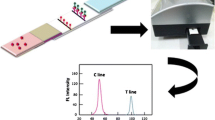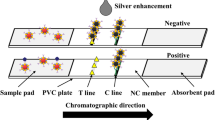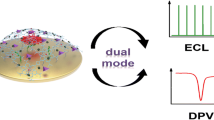Abstract
The presence of cyanobacterial hepatotoxins such as microcystin-LR poses health threats to humans due to their potential for causing severe physiological effects when contaminated drinking water is ingested. Here, the electrochemical detection of microcystin-LR is explored using a quantum dot/antibody (QD/Ab) probe for nanoparticle-based amplification and direct electrochemical transduction. The immunological recognition of microcystin-LR using the QD/Ab probe was amplified and converted to an electrochemical signal by measuring the cadmium ions released from QD based on square wave stripping voltammetry under optimized electrochemical factors. Whereas a qualitative analysis for microcystin-LR was achieved using the specific peak potential of the anodic voltammogram at −0.6 ± 0.05 V, concentration of the toxin was quantified based on the charge density of the anodic peak; a dynamic range of 0.227 to 50 μg/L and limit of detection of 0.099 μg/L were obtained with high sensitivity. The extracted microcystin-LR from Microcystis aeruginosa was estimated as 1,944 μg/g of dried weight of the microorganism.






Similar content being viewed by others
References
Robillot C, Vinh J, Puiseux DS, Hennion MC (2000) Environ Sci Technol 34:3372–3378
McElhiney J, Lawton LA (2005) Toxicol Appl Pharm 203:219–230
Falconer I, Bartram J, Chorus I, Kuiper GT, Utkilen H, Burch M, Codd GA (1999) Safe levels and safe practices. E. & F.N. Spon, London
MacKintosh C, Beattie KA, Klumpp S, Cohen P, Codd GA (1990) FEBS Letters 264:187–192
Bhattacharya R, Sugendran K, Dangi RS, Rao PV (1997) Biomed Environ Sci 10:93–101
Nishiwaki MR, Ohta T, Nishiwaki S, Suganuma M, Kohyama K, Ishikawa T, Carmichael WW, Fujiki H (1992) J Cancer Res Clin Oncol 118:420–424
Zhan L, Sakamoto H, Sakuraba M, Wu D-S, Zhang L-S, Suzuki T, Hayashi M, Honma M (2004) Mutat Res-gen Toxen 557:1–6
Kuiper GT, Falconer IR, Fitzgerald J (1999) Toxic Cyanobacteria in water—a guide to their public health consequences, monitoring and management. Chorus, I., Bartram, J. ed WHO, E & FP Spon, London
Azevedo SMFO, Carmichael WW, Jochimsen EM, Rinehart KL, Lau S, Shaw GR, Eaglesham GK (2002) Toxicology 181–182:441–446
Zurawell RW, Chen H, Burke JM, Prepas EE (2005) J Toxicol Env Heal B 8:1–37
WHO (1999) Toxic cyanobacteria in water: a guide to their public health consequences, monitoring and management
Campas M, Szydlowska D, Trojanowicz M, Marty JL (2005) Biosens Bioelectron 20:1520–1530
Campas M, Marty JL (2007) Biosens Bioelectron 22:1034–1040
Dürkop A, Wolfbeis O (2005) J Fluoresc 15:755–761
Goldman ER, Clapp AR, Anderson GP, Uyeda HT, Mauro JM, Medintz IL, Mattoussi H (2004) Anal Chem 76:684–688
Wang J (2003) Anal Chim Acta 500:247–257
Lee JW, Yu HW, Kim IS (2007) J Korean Society on Water Quality 23:705–711
Merkoc A, Marcolino JLH, Fatibello FSM, Alegret S (2007) Nanotechnology 3:6–12
Rosi NL, Mirkin CA (2005) Chem Rev 105:1547–1562
Dai Z, Kawde AN, Xiang Y, La BJT, Gerlach J, Bhavanandan VP, Joshi L, Wang J (2006) J Am Chem Soc 128:10018–10019
Falconer IR (1993) Algal toxins in seafood and drinking water. Academic, London
Bouaïcha N, Maatouk I, Vincent G, Levi Y (2002) Food Chem Toxicol 40:1677–1683
Rapala J, Erkomaa K, Kukkonen J, Sivonen K, Lahti K (2002) Anal Chim Acta 466:213–231
Nagata S, Soutome H, Tsutsumi T, Hasegawa A, Sekijima M, Sugamata M, Harada K, Suganuma M, Ueno Y (1995) Nat Toxins 3:78–86
Metcalf JS, Codd GA (2000) FEMS Microbiol Lett 184:241–6
ISO (2005) Water quality. Determination of microcystins. Method using solid phase extraction (SPE) and high performance liquid chromatography (HPLC) with ultraviolet (UV) detection. International Organization for Standardization
Noh M, Tothill I (2006) Anal Bioanal Chem 386:2095–2106
Oliver RL (1994) J Phycol 30:161–173
Song L, Sano T, Li R, Watanabe MM, Liu Y, Kaya K (1998) Phycol Res 46:19–23
Harada K, Matsuura K, Suzuki M, Watanabe MF, Oishi S, Dahlem AM, Beasley VR, Carmichael WW (1990) Toxicon 28:55–64
Domingos P, Rubim TK, Molica RJR, Azevedo SMFO, Carmichael WW (1999) Environ Toxicol 14:31–35
Fanta K, Chandravanshi BS (2001) Electroanal 13:484–492
Michael TL, Murimboh J, Hassan NM, Chakrabarti CL (2001) Electroanal 13:94–99
Mocak J, Bond AM, Mitchell S, Scollary G (1997) Pure Appl Chem 69:292–328
Lei LM, Wu YS, Gan NQ, Song LR (2004) Clinica Chimica Acta 348:177–180
Sheng JW, He M, Shi HC, Qian Y (2006) Anal Chim Acta 572:309–315
Loyprasert S, Thavarungkul P, Asawatreratanakul P, Wongkittisuksa B, Limsakul C, Kanatharana P (2008) Biosens Bioelectron 24:78–86
Oudra B, Loudiki M, Vasconcelos V, Sabour B, Sbiyyaa B, Oufdou K, Mezrioul N (2002) Environ Toxicol 17:32–39
Acknowledgments
This research was supported by a grant (07SeaHEROA01-01) from the Plant Technology Advancement Program funded by the Ministry of Land, Transport and Maritime Affairs of the Korea Government.
Author information
Authors and Affiliations
Corresponding author
Rights and permissions
About this article
Cite this article
Yu, HW., Lee, J., Kim, S. et al. Electrochemical immunoassay using quantum dot/antibody probe for identification of cyanobacterial hepatotoxin microcystin-LR. Anal Bioanal Chem 394, 2173–2181 (2009). https://doi.org/10.1007/s00216-009-2910-x
Received:
Revised:
Accepted:
Published:
Issue Date:
DOI: https://doi.org/10.1007/s00216-009-2910-x




